How to Grow Garlic: Tips for Growing Great Garlic
This post may contain affiliate links, which means that I may receive a commission if you make a purchase using these links. As an Amazon Associate I earn from qualifying purchases.
With a bit of planning at planting time, garlic is one of the most trouble-free crops you can grow in the garden. Learn how to grow garlic with this comprehensive guide.
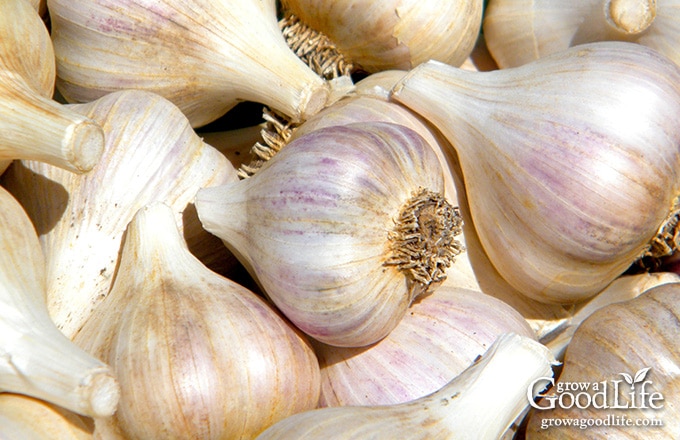
Garlic is a staple in the kitchen and adds lots of flavor to meals. You can grow garlic in a variety of climates. It doesn’t take up a lot of space in the vegetable garden or require much attention once planted. All you need is an area that gets plenty of sun and these helpful tips for growing garlic.
About Garlic
Garlic (Allium sativum L.) is a member of the Liliaceae family and genus Allium, which includes chives, leeks, onions, and shallots.
While archeologists have found evidence that garlic was grown and consumed while building the pyramids in Egypt between 2780 and 2100 BC, it is believed that the origins are in central Asia, where it once grew wild. Today, garlic is cultivated worldwide as a seasoning for food and medicinal properties.
Why Grow Garlic?
- More Variety: There are more than 200 cultivars of garlic available in from seed catalogs and farmers’ markets in the United States. Only two varieties are commonly found in grocery stores. If you like cooking and eating garlic, growing your own lets you add different types to your meal planning.
- Staple Ingredient in Cooking: Garlic is an essential ingredient for adding flavor to many cuisines from around the world, including soups and stews, snacks and dips, stir-fry and salsas, breads, and flavored butters. It is worthwhile to keep garlic on hand with so many culinary uses.
- Health Benefits: Garlic has documented health benefits. It can help boost the immune system, reduce high blood pressure, and has antibiotic and anti-fungal properties. So it is a good idea to include garlic in your diet.
- Easy to Grow: Garlic is a pretty low-maintenance crop and is not bothered by many pests and diseases. Other than a bit of side dressing of compost in early spring, mulching, and occasional watering during dry spells, your garlic will grow well without a lot of care.
- Stores Well: Once cured, garlic has a long shelf life. With just a little space in your garden, you can grow enough garlic to last most of the year.
- Replant Cloves: You’ll only need to buy garlic seed once because you can harvest in summer and replant your homegrown cloves again in fall. If you continue to plant your largest cloves each year, your garlic will adapt over time to your soil and climate.
Types of Garlic to Grow
There are two main subspecies of garlic, hardneck (Allium stivum ophioscorodon) and softneck (Allium sativum sativum). Our understanding of the many varieties of garlic and how they are related is evolving. However, there are ten main types of garlic right now, including eight hardnecks and two softnecks, and many varieties within each class.
Hardneck Garlic
Hardneck garlic, also called stiffneck varieties, are more suited for areas with cold winters. This cultivar requires a period of cold temperatures to stress the seed and stimulate it to divide into separate cloves that form a head of garlic. This process is called vernalization. If hardneck garlic doesn’t get a cold period of at least 40˚F for about 4 to 8 weeks, it may not divide into cloves that form the bulb.
Hardneck varieties grow a woody stalk in the middle of the bulb, and the cloves form in a single layer around it. A few weeks before the garlic is finished growing, it will send up a flower stalk from the stem called a “garlic scape.” The stalk gives the garlic a stiff stem or hardneck.
If you are growing hardneck garlic, it will give you two harvests. Topping or cutting the garlic scape helps the plant focus its energy on developing a large bulb. Garlic scapes are edible and have a delicious, mild garlic flavor.
There are eight sub-varieties of hardneck garlic, including true hardneck and weak hardnecks. Weak hardnecks often grow more like softneck garlic and don’t form scapes depending on the environment.
- Porcelain garlic has a strong garlic flavor and forms 4 to 6 large cloves per bulb with white skins and sometimes pink-tinged cloves. It stores well, about 10 months in a cool location. Porcelain varieties include Armenian, Georgian Crystal, German Extra Hardy, Italian Red, Music, Northern White, Romanian Red, and Zemo.
- Rocambole garlic has thin papery wrappers and shorter storage life of only 4 to 6 months, but they have the richest, slightly sweet flavor. The bulbs form 8 to 10 cloves that can be brownish in color with solid, splotched, or streaked patterns. The garlic scape forms a double loop. Types of rocambole garlic include Amish, Italian Purple, German Giant, German Red, Killarney Red, Russian Giant, and Spanish Roja.
- Purple Stripe garlic is believed to be the ancestor of all garlic. The skins and cloves have reddish-purple lines and grow 8 to 12 cloves per bulb, depending on the type. The cloves are tall, slender, have pointy tips, and have a thick paper skin that helps them last 9 to 12 months in storage. The cloves have an intense garlic flavor when raw, but the flavor sweetens when roasted or sautéed. Purple stripe varieties include Belarus, Chesnok Red, and Persian Star.
- Marbled Purple Stripe garlic was once classified with purple stripe garlic but is now separated into its own variety. The cloves are very large, with bold purple-blotched marbling and elongated bulbs. The scapes can be quite tall, up to 6 feet. Marbled varieties have adapted to grow well in both cold and warm climates. They also last a long time in storage, about 9 to 12 months. Varieties include Duganskij, Metechi, Northern Siberian, and Pskem.
- Glazed Purple Stripe was also once grouped with purple striped, but is now grouped into its own variety known for its glazed or matte metallic colored bulb wrappers. The cloves are not as elongated or large as purple striped but are full of hot garlic flavor. Expect 6 to 12 cloves per bulb. The paper wrappers are more delicate and require careful harvesting. Because of this, they may not last as long in storage, up to 6 to 8 months. Varieties included Celeste, Purple Glazer, Red Rezan, and Vekak.
Weak Hardnecks
Weakly bolting hardnecks are sometimes classified as softnecks in seed catalogs. These are genetically related to softneck silverskins but may form scapes or bulbils along the stem.
- Creole garlic, sometimes called Mexican purple garlic, grows well in cold and warm climates and produces small but intensely flavored bulbs with excellent storage capabilities. They often have 8 to 12 red to dark purple colored cloves per bulb surrounded by white wrappers. Varieties include Ajo Rojo, Burgundy, Creole Red, Germinador, Pescadero Red, Rose De Lautrec, Spanish Benitee.
- Asiatic garlic forms medium-sized bulbs with white skins and 4 to 8 deep purple, brown, or red cloves. If it does form scapes, the flower is different than other garlic and resembles a long, dark, and wrinkled bean pod. The bulbs size up very well without removing the stalk. Asiatic garlic usually matures earlier than other varieties and should be harvested just as soon as leaves begin to brown. Asiatic garlic varieties include Asian Tempest, Korean Red, Pyongvang, and Russian Inferno.
- Turban garlic grows squat heads with 5 to 7 fat brownish to purplish cloves that taste hot when raw and mild when cooked. The plants sprout early in spring and mature quickly. When Turban garlic does develop scapes, the stalks droop instead of curling, and the flower pod is shaped like a turban. Leaving the flower stalks on the plant will not affect bulb growth. Turban varieties include Red Janice, Sonoran, Thai Purple, and Xian.
Softneck Garlic
Softneck garlic is the type of garlic we are used to seeing at the supermarket. It has multiple cloves enclosed in a white wrapping. The flavor is mild and has a reputation for lasting a long time in storage. There are 2 sub-varieties of softneck garlic, artichoke and silverskin.
Softneck garlic is less cold hardy in extreme northern areas and grows better in warmer climates. Softneck varieties do not produce a scape, but you can braid the foliage for hanging. They also tend to mature at different rates, so you’ll need to watch the plants and harvest once the lower leaves begin turning brown.
- Artichoke garlic is named for the overlapping clove pattern throughout the bulb, similar to an artichoke. The mild-flavored bulbs are large and produce 12 to 20 layered cloves encased in a white or lightly streaked wrapper. It does not form a flower stalk but may produce bulbils that will protrude from the lower part of the stem. Artichoke garlic varieties include California Early, Italian White, Inchelium Red, Lorz Italian, and Polish White.
- Silverskin garlic is the preferred variety to grow for many gardeners because it grows well in many climates, produces the highest yields, and has the longest storage capacity. Each bulb contains 12 to 20 cloves wrapped well in layers of papery skin. Silverskin garlic types include Nootka Rose, Silver Rose, Sicilian Silver, and Silver White.
Tips for Growing Garlic
Garlic has a unique growing period compared to other garden crops. It is planted in the fall and harvested the following year. Here are tips for growing garlic:
How Does Garlic Grow?
Garlic is a bulbing plant that grows from individual cloves broken off from a whole bulb. When planted, each clove will multiply in the ground, forming a bulb that consists of 6 to 12 cloves.
Garlic is planted in the fall for larger bulbs. Once planted, the garlic begins growing roots and then goes dormant when winter comes. Once spring arrives, fall-planted garlic will begin growing right where it left off, producing large green foliage that can grow up to two feet in height.
Garlic is triggered to bulb when the day length increases to about 14 hours. Therefore, the more time garlic has to grow foliage before forming bulbs, the larger the heads will be at harvest time.
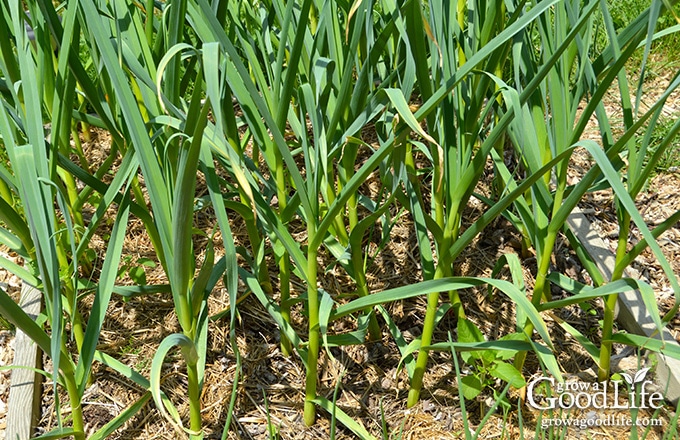
When to Grow Garlic
If you are aiming for large bulbs, the best time to plant garlic is in the fall. The time to plant is based on the estimated hard frost date for your area. You can find your estimated fall frost date by contacting your local extension office or looking it up by zip code at PlantMaps.com. Plant garlic seed 4 to 6 weeks before your estimated hard frost date in fall.
Plant at the optimum time for your area: Gardens in zones 0 to 4 should plant garlic in late August to September, while zones 5 to 8 should plant garlic in mid-October through mid-November, and zones 9 to 10 in late November to December or before the ground freezes. You can find your gardening zone by entering your zip code on USDA Plant Hardiness Zone Map website.
The goal of planting in the fall is to give the garlic a head start. Once the garlic is planted, it will begin to send out roots. The garlic goes dormant when the cold weather arrives, and the ground freezes and begins growing again as soon as the soil warms in the spring. When garlic grows the following year, it is triggered to bulb when the day length increases to about 14 hours.
Overwintering in the ground also allows the bulb to experience a cold period necessary for bulb formation. Garlic needs a period of cold temperatures for the seed to split into individual cloves that shape a head of garlic. Hardneck garlic needs about 5 weeks of temperature below 40˚F, while softneck garlic is more tolerant of warm winters.
Select Varieties that Grow Well in Your Area
When purchasing your garlic seed, try to buy from a supplier with a similar growing environment. Garlic is adaptable to many growing conditions, but it can take several years to adjust. You will get better results right away if you grow garlic that is conditioned to your climate and soil type.
Generally, hardneck types do well in cold climates, while softneck types need less of a cold period to develop bulbs.
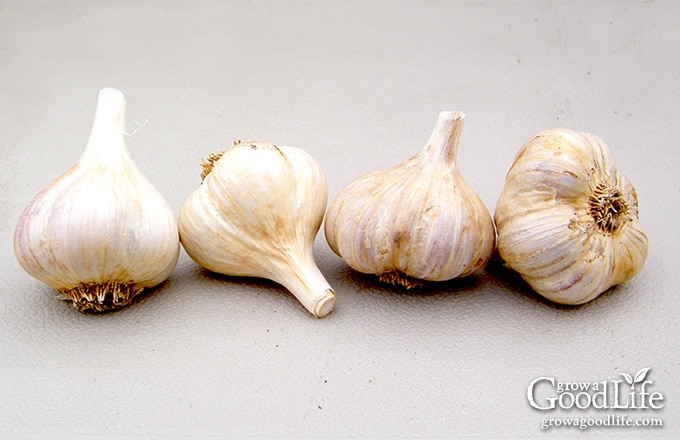
Purchase Garlic Seed from a Trusted Source
Planting with good quality, organic seed stock will get your garlic crop off to a good start with fewer chances of disease. Garlic seeds are the individual cloves that make up a bulb of garlic.
The common white grocery store garlic shouldn’t be used for seed. Chances are that garlic was grown in the mild climate of northern California or even outside the country. It also may have been chemically treated so it won’t sprout. Instead, purchase certified seed garlic for the best results. You can find seed garlic at local garden centers and online.
Some online sources I have used include High Mowing Seeds, Pinetree Garden Seeds, and FEDCO. Other trusted sources include Botanical Interest, Territorial Seeds, and Seed Saver’s Exchange. Online ordering usually opens in summer for fall delivery. Also, consider your local farmers’ markets, feed stores, county fairs, garlic festivals, or fellow gardeners in your area.
Try not to be shocked at the initial price of garlic seed. Remember, each clove will grow another head of garlic and produce plenty for eating and garlic seed for years to follow. Depending on the variety, one pound of garlic seed can yield 40 garlic bulbs or about 5 pounds of garlic.
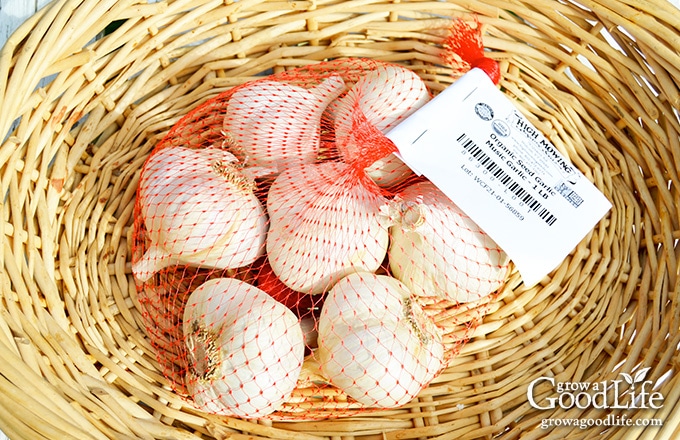
How to Grow Garlic
Garlic thrives in full sun in loose soil with lots of organic matter. Choose a well-drained garden bed that receives 6 to 8 hours of direct sunlight per day. Select an area that did not have onions or other alliums growing this year.
Remove weeds, work in a generous layer of finished compost, and a balanced, slow-release organic fertilizer. If the weather has been dry, water your garden bed well a day before planting.
This tutorial shows all the steps of planting garlic, including dividing the bulbs into cloves, plotting out your growing area, and placing the garlic cloves in the ground: How to Plant Garlic in Fall
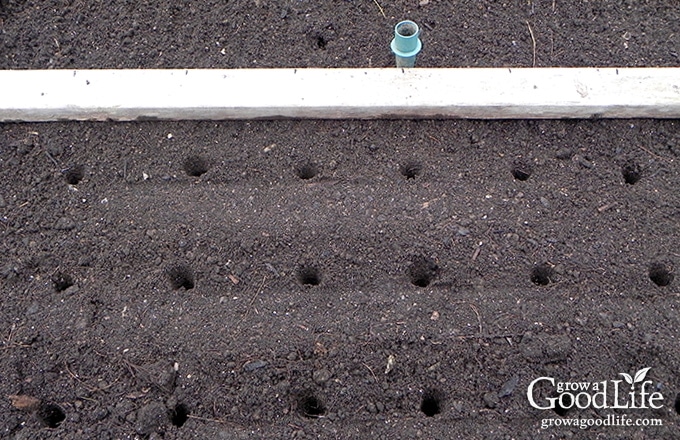
Mulch to Prevent Weeds and Conserve Moisture
Water the garlic bed well after planting and add a light layer of mulch to keep the weeds down until the ground freezes. I like using shredded leaves since they are plentiful in fall, but you can use any type of organic mulch to do the job.
Adding a heavy layer of mulch before the ground is frozen can insulate the bed and delay the plants from going dormant naturally. Unfortunately, this can cause damage to the roots once the severe winter arrives.
Once the ground does freeze, add another layer of mulch to insulate and keep the soil frozen. The mulch will protect the roots and prevent the garlic from being heaved out of the ground by alternate freezing and thawing.
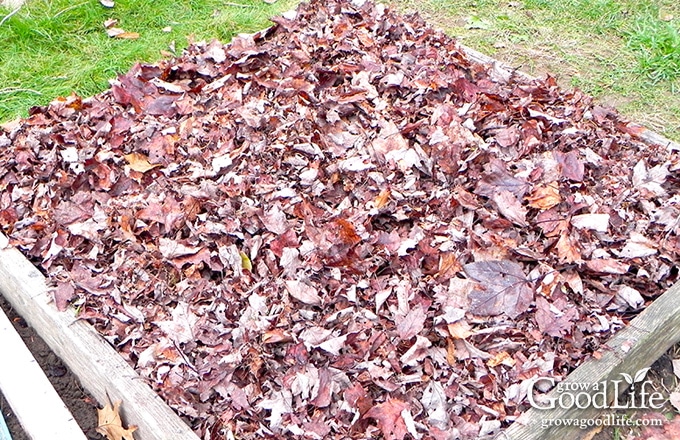
How to Care for the Plants
Once spring arrives, after the snow melts and the soil warms, green garlic sprouts will emerge from the mulch you laid last fall. Here are tips to help your plants grow healthy:
Fertilizing
If you used good quality compost and slow-release organic fertilizer at planting time, your garlic is off to a great start. A supplemental application of nitrogen-rich fertilizer in early spring will boost the foliage and help produce healthy green growth.
Once the garlic emerges, side-dress the plants with composted chicken or poultry manure or an organic nitrogen fertilizer such as blood meal or feather meal. Pull the mulch away, and apply the fertilizer several inches away from the stems of the plants. Gently scratch it into the soil, tuck the mulch back in, and water well.
Additionally, you can water with an organic fish emulsion fertilizer if the foliage shows signs of stress, such as yellow tips. Follow the directions on the bottle. Don’t be tempted to over-fertilize, or you may delay or reduce bulb growth, and stop fertilizing once the bulbs form.
Watering
Garlic needs about one inch of water each week, either by rain or hand watering, especially once the bulbs form. Water the garlic when the soil feels dry an inch beneath the surface. Let the water soak in 6 to 8 inches to encourage deep root growth.
Water your plants in the morning or early afternoon, and avoid getting any part of the plant wet. Use drip irrigation, a soaker hose, or hand water with a watering wand to deliver water at the soil level.
Mulching the Soil
Add another layer of mulch once the ground warms in spring. Garlic has a shallow root system and will stop growing in dry soil conditions or when the roots get too hot. Mulching the soil surface with shredded leaves or straw will help insulate the roots, conserve moisture, and help suppress weeds.
Keeping Up with the Weeds
The mulch will help keep the weeds down, but you will need to pull out the few that manage to sprout through so they don’t compete with your garlic for nutrients and moisture. Weed the garden frequently, especially early on when the plants are young: Tips for Controlling Weeds in the Garden
Removing the Garlic Scapes
Garlic scapes are the flower stalks that hardneck garlic plants produce. Several weeks before the garlic bulb has finished growing, it sends up a flower stalk. The stem grows upwards for several inches, then will curl once or twice before continuing to grow upward.
Removing the garlic scape allows the plant to devote its energy to growing a larger garlic bulb. These tender, mildly garlic flavored shoots are edible. Substitute them in recipes that call for garlic. See 10 Ways to Use Garlic Scapes for details on how to harvest, plus ways to use and preserve garlic scapes.
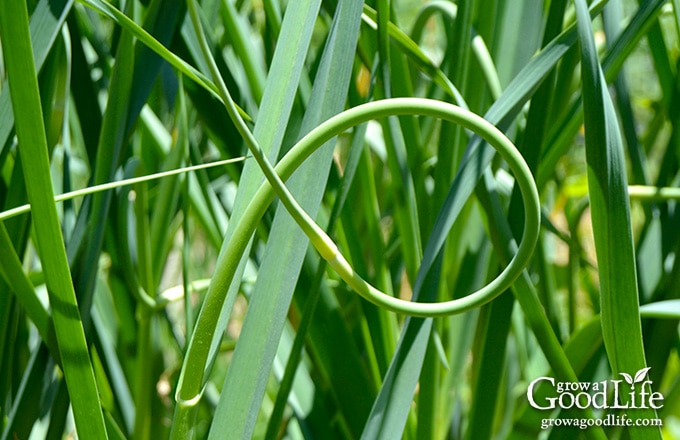
Watch for Pests and Diseases
Inspect your plants weekly and look for signs of pests and diseases that affect garlic bulbs and foliage. Not many pests bother garlic because the scent is a natural insect repellant. But there are a few that can cause damage to the bulbs, including bulb mites, leafminers, thrips, nematodes, leek moth, and wireworms.
Fungal diseases are more likely to occur if conditions are humid and wet. Planting in well-draining soil, practicing good garden hygiene, and rotating your crops will help prevent issues. Some common diseases garlic plants experience include downy mildew, purple blotch, garlic rust, and white rot.
Time Your Garlic Harvest
You can harvest at any time for fresh eating. However, if you are growing garlic for long-term storage, you need to let the garlic mature and reach the maximum size, but not so long that the cloves separate because these bulbs store poorly.
The number of days to maturity varies with the climate and variety of garlic grown, but October planted garlic is usually ready by mid-July in my Maine, zone 5 garden. If you are in a warmer climate, begin checking your garlic in June.
Different varieties are ready to harvest at different times. Generally, Asiatics and Turbans mature first, followed by Artichokes, Creoles, Rocamboles, Purple Stripes and Porcelains, and finally Silverskins.
Knowing when to harvest garlic can be tricky. Lifting the bulbs too early will give you undeveloped, small bulbs. Harvesting too late and the cloves could split through their skins. Either situation will affect the garlic’s long-term storage potential.
Garlic is finished growing when the foliage begins to turn brown. Leaves grow from the bottom up, so the ones at the bottom will die back first. Dig up a test bulb once the bottom 2 to 3 leaves turn brown. The cloves should be large, and the skins filled out and tight. Stop watering and wait for a dry period to dig up the bulbs.
This article provides more information on how to tell when garlic has finished growing and how to harvest and prepare it for winter food storage:
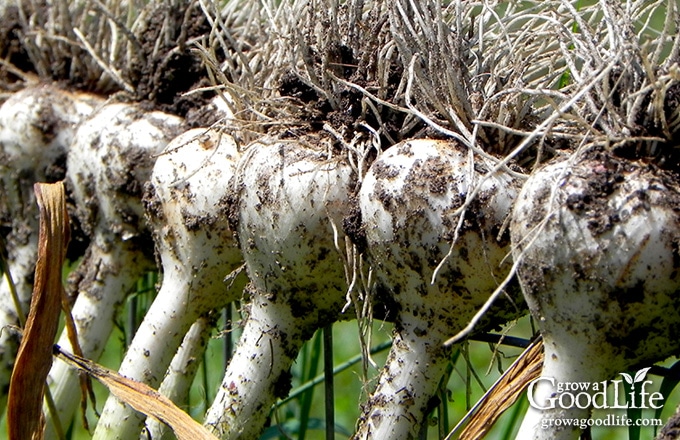
Can You Plant Garlic in Spring?
If you missed your chance to plant garlic in fall, you could still plant spring garlic. You may not get large bulbs, but immature garlic bulbs are delicious and have a mellower flavor than regular garlic. Green garlic and the foliage can be used raw or cooked like scallions. You can often find garlic bulbs for spring planting at your local garden centers near the onion sets and seed potatoes. Read on for tips on how to grow green garlic:
Can You Plant Sprouted Garlic?
Don’t let sprouting garlic go to waste. If your garlic germinates, you can plant it any time and let it grow. You can also grow green garlic in containers. Just fill your pot with soil and push the cloves in about 2 to 4 inches apart and 1 inch deep.
It probably won’t divide into large garlic cloves without a cold period, but you can still harvest and enjoy the mild-flavored garlic shoots and green garlic. Garlic greens can be chopped and used to flavor foods, just like chives, while you can use small garlic bulbs in any recipe like regular garlic.
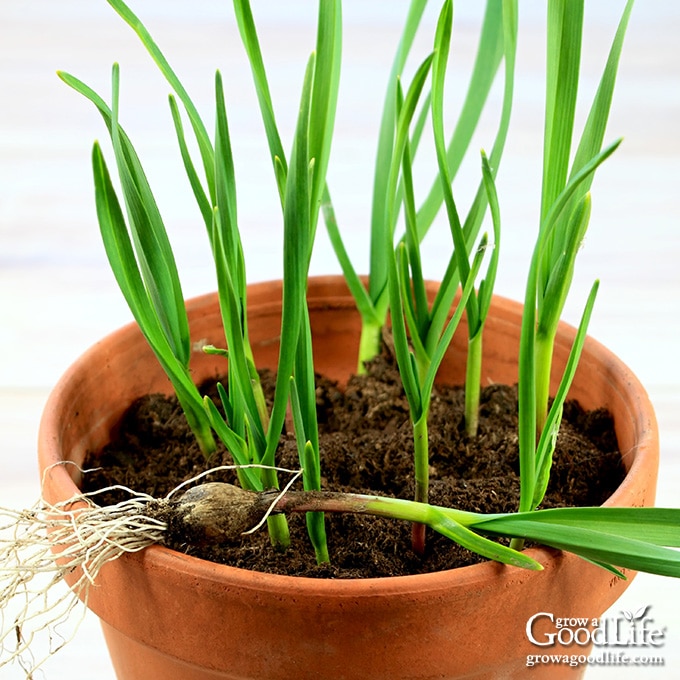
Ways to Preserve Garlic
Whole heads of freshly harvested garlic will last several months at room temperature when stored in a pantry or shelf with good ventilation. However, once you remove the cloves from the bulb, expect them to only last several weeks before they shrivel up. Luckily, there are several ways to preserve garlic:
Root Cellar Storing
You don’t need a root cellar to store garlic long-term. Any area in your home that stays cool will do the trick. Ideal storage conditions for garlic are at temperatures between 32˚F to 50˚F in a dry location with 50-60% relative humidity. A cold room, such as a closet or unheated basement, is a great location to store food for winter.
Storing garlic under the right conditions will help keep it fresh and maintain its flavor and potency for many months. Garlic can last 6 to 12 months in storage, depending on the variety. Please read this article below for tips to help you properly cure freshly harvested garlic and store it for winter: How to Harvest, Cure, and Store Garlic for Winter
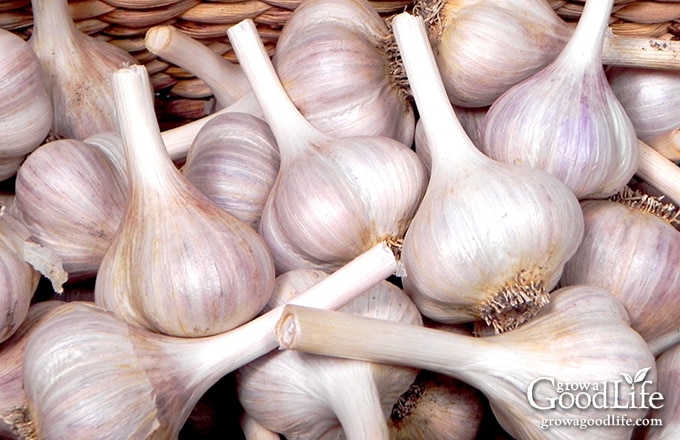
Freezing Garlic
Freezing garlic cloves, minced garlic, pureed garlic in oil, or roasted garlic paste is a great way to preserve the fresh flavor for all your winter meals. In addition, you will love the convenience of having prepared garlic ready to go at mealtime. Discover four ways to freeze garlic in this step-by-step tutorial: How to Freeze Garlic.
Pickled Garlic
Pickling is a way to preserve fresh garlic cloves in a vinegar brine infused with spices. Pickling mellows the intense flavor of garlic and gives it a sweet, tangy, and spicy flavor. Using a boiling water bath canner to can the jars makes the pickled garlic shelf-stable for long-term food storage. See how to make and can pickled garlic with this tutorial: How to Make Pickled Garlic.
Dehydrating Garlic
Use a food dehydrator to turn your garlic harvest into shelf-stable garlic flakes or powder. You can make homemade garlic powder by drying and grinding garlic cloves.
Using garlic powder in your cooking is a quick way to add lots of flavor to a dish. It combines effortlessly with the other dried herbs and spices to make shelf-stable rubs and spice blends. Follow the tutorial in this article: How to Dehydrate Garlic and Make Homemade Garlic Powder.
—
Garlic is a great crop to include in your vegetable garden. It doesn’t take up a lot of space or require a lot of attention once planted. I hope these tips have encouraged you to grow your own garlic.
You May Also Like:
- 14 Crops for Winter Food Storage
- 10 Reasons to Grow Your Own Organic Food
- 7 Tips to Prepare Your Garden for Winter
Good planning is key to a successful vegetable garden
Whether you are new to growing your own food or have been growing a vegetable garden for years, you will benefit from some planning each year. You will find everything you need to organize and plan your vegetable garden in my PDF eBook, Grow a Good Life Guide to Planning Your Vegetable Garden.


I have what a friend of mine calls elephant garlic. She dug up several plants for me. They have straight scapes. I planted them today (May). Should I cut the scapes off? These scapes are straight, not curly.
the jet, Elephant garlic doesn’t produce curly scapes like regular garlic. Cut the scape off once it reaches about 12-inches tall and before it blooms. Trimming off the flower stalk allows the plant to concentrate on forming a large bulb. I have never transplanted garlic, but if the plants take, the bulbs should be ready to harvest in 3-4 weeks. Go ahead and pull the garlic sooner if the leaves die.
I’m not positive what month my husband planted our garlic last fall but our scapes have already started to twist. I’m in zone 7b. Should I cut the scapes now in order to give energy to the bulb? If it’s usually harvested mid July, it seems somewhat early for it to be nearing harvest?
Quanna, Yes, it sounds like your garlic scapes are ready to harvest. The garlic bulbs will be ready to harvest when the bottom 3 leaves turn brown.
I harvested my garlic in July. It is now late September and new plants are growing where the original garlic heads were. I did not plant these. I dug one up and it looks almost like a small onion, and has a very sharp garlic taste. I never had this before and wonder why these are growing.
Marie, You may have missed a few small bulbs under ground when you harvested in July. Now the individual bulbs are sprouting. Or maybe a few cloves you planted were slow to sprout. I would just leave them be. They will stop growing when the ground freezes, and begin growing again in spring. You will be able to enjoy spring garlic shoots.
I’m in zone 7. I haven’t planted my garlic as of yet. My question: Our predicted temps are diving down to below freezing for the next week or so. Should I wait to plant when it warms up for a bit or can I go ahead with planting now? Today the soil is still loose and very workable. The cold temps start tonight. (I have hard necks)
Jean, You can plant your garlic as long as the soil is workable. One year, I even removed the first few inches of frozen soil and planted my garlic. Then I placed the frozen soil on top, mulched, and hoped for the best. The following year, every clove of garlic sprouted.
Can you plant the seeds from the bulb~flower?
Alicia, Yes, you can plant the seeds from the bulbs. It is rather difficult to grow garlic this way. However, if you are up for the challenge, here is a great post: http://garlicseed.blogspot.com/p/growing-garlic-from-true-seed.html
How long does it take from planting to harvesting garlic?
Tebono, Garlic takes about 6 months to mature. The time to maturity varies with the climate and variety of garlic grown. We plant ours in October, and then it stays dormant through winter (December, January, and February). It begins growing in spring and is harvested in mid-July in my Maine, USA garden. Search for “how to grow garlic in [your location]” and you will find more information that will relate to your area.
Can you plant two varieties in one bed?
Yes, you can. They will both have the same growing needs, so caring for both varieties will be the same.
Does garlic need to be completely naked or can the “jacket” be left on?
Barbara, Yes, you can leave the jacket on 🙂
Thank you for this post, it is most helpful and encourages me to get out there next month and get my garlic cloves in the ground for next year!